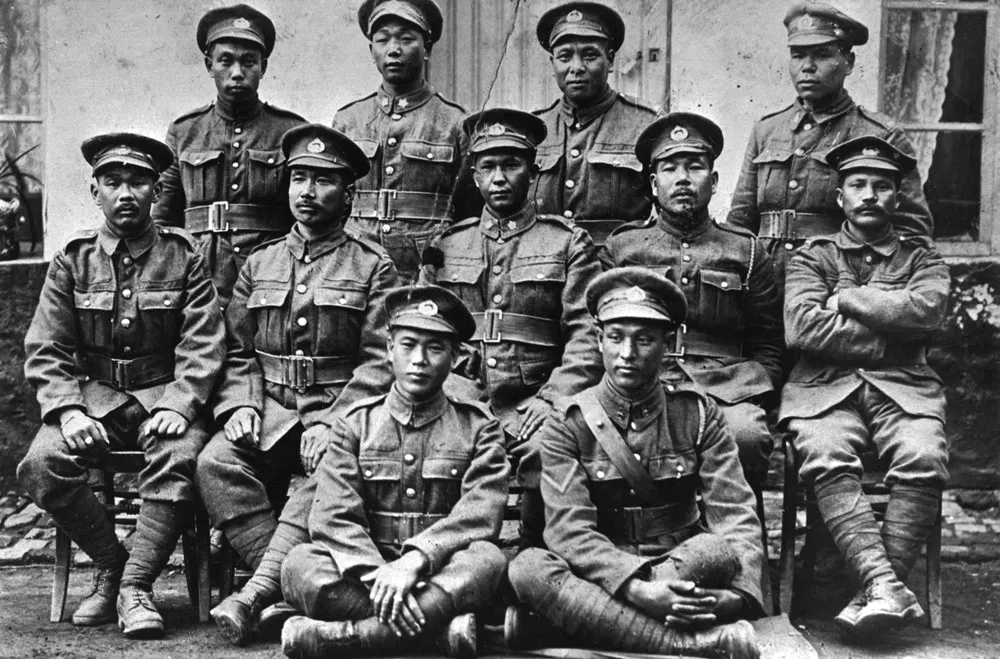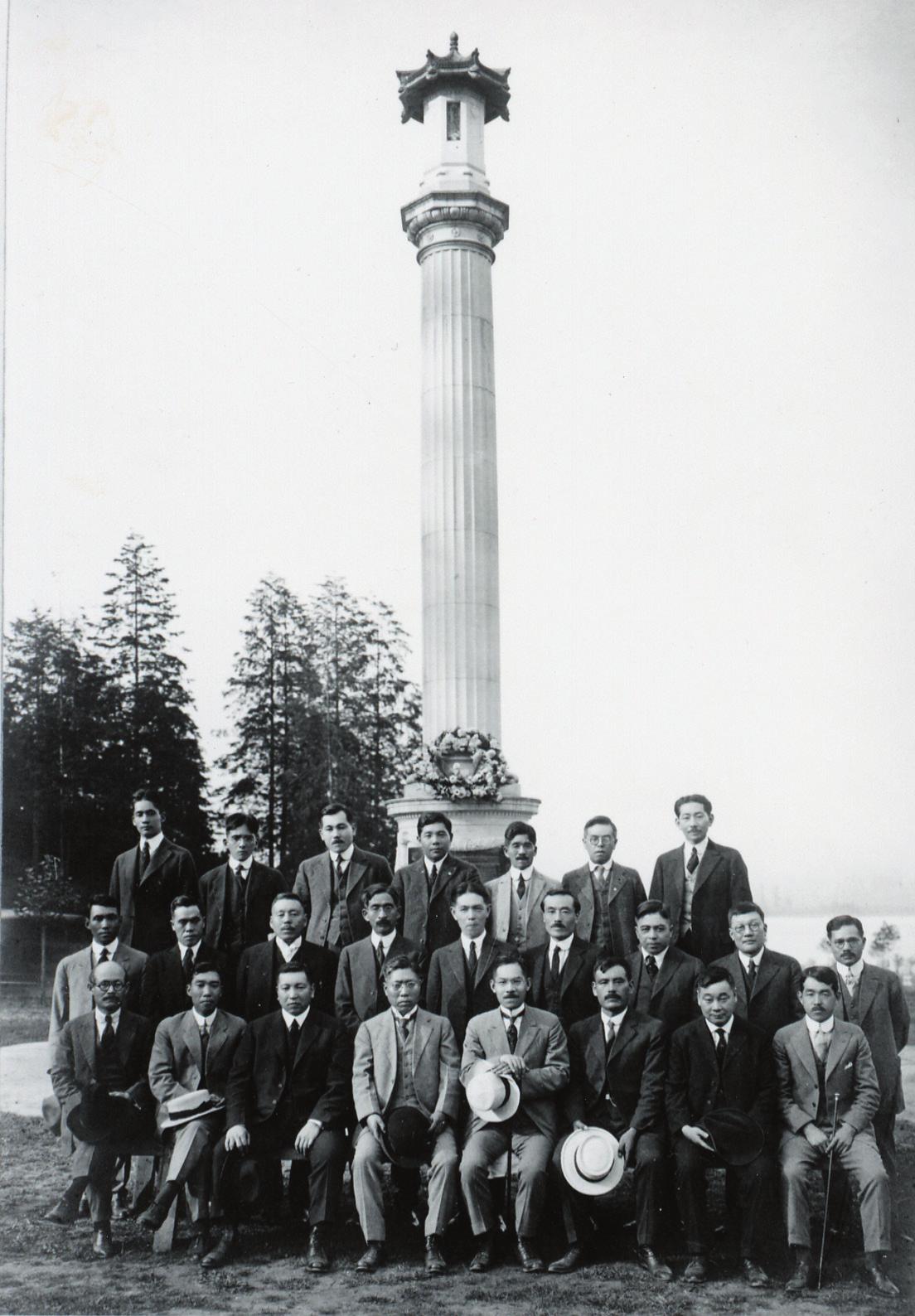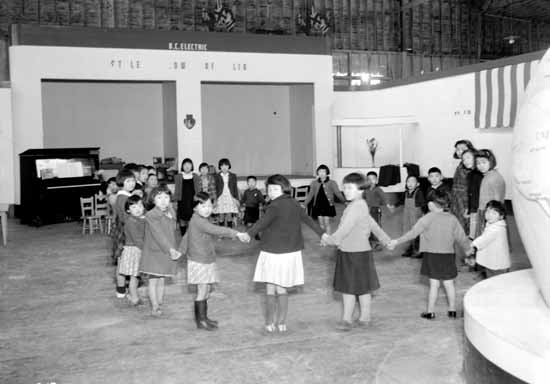| Race in America:
Canada’s Shame
By Mike Bennighof, Ph.D.
May 2022
 On 9 April 1920, the Japanese Canadian Association dedicated the Japanese Canadian War Memorial in Vancouver’s Stanley Park. The Memorial, modeled on the traditional Kasuga lantern, includes an “eternal flame of memory” for the 54 Japanese-Canadians killed in action in the Great War while fighting for their country. On 9 April 1920, the Japanese Canadian Association dedicated the Japanese Canadian War Memorial in Vancouver’s Stanley Park. The Memorial, modeled on the traditional Kasuga lantern, includes an “eternal flame of memory” for the 54 Japanese-Canadians killed in action in the Great War while fighting for their country.
On 24 February 1942, Canadian Prime Minister Mackenzie King ordered the eternal flame extinguished. Not satisfied with that desecration, in the following days the King government would direct that 23,000 people of Japanese ancestry, about 12,000 of them Canadian citizens, be seized and deported to concentration camps in the interior of Canada.
Unlike the United States, Canada formed no ethnic Japanese units during the Second World War; Japanese-Canadians were barred from enlisting in the Canadian armed forces for most of the war, though the Canadian Army did retain the 32 Nisei soldiers who had enlisted before the Pearl Harbor attack.
Japanese immigration to Canada began with Manzo Nagano, a salmon fisherman who arrived in British Columbia in 1877. Others followed, sparking confrontations with white residents as they went to work in a variety of occupations rather than restrict themselves to low-wage, unskilled labor as the previous wave of Chinese arrivals had done. In 1907, American laws forbidding Japanese immigration diverted perhaps 7,000 Japanese to British Columbia, resulting in anti-Japanese riots in Vancouver. Afterwards, Canada set a quota of 400 Japanese male immigrants allowed per year, and any number of women.
Unlike the United States, Canada did not restrict the ability of these immigrants or their children to seek or obtain Canadian citizenship. Instead, following a 1902 Privy Council decision that overturned lower court orders, it simply barred them from registering to vote – not only immigrants, but their descendants as well.

They fought for Canada. She put them and their children in concentration camps. Japanese-Canadian soldiers of the 10th Battalion, Canadian Expeditionary Force.
When Canadian troops mustered for the First World War, they did not include Japanese-Canadians. The Japanese Canadian Association prevailed on the government to allow volunteers, offering to pay for the training and equipment of a Japanese-Canadian infantry battalion. In all, 277 Japanese-Canadians from British Columbia sponsored by the Japanese Canadian Association entered the Army, and about 125 others who successfully enlisted in other provinces. In addition to the 54 killed, 92 more were wounded. Thirteen Japanese-Canadians received the Military Medal for Bravery.
Additional legal restrictions, mostly within the fishing industry, appeared in the decades between the world wars. Those laws and labor rules led Japanese-Canadians into other industries and professions, in turn ramping up the racist anger of white Canadians. On small gain came in 1931, when the British Columbia legislature allowed Japanese-Canadian veterans of the Great War – but not any family members or descendants – to register and vote.

Veterans dedicate the Japanese Canadian War Memorial, 9 April 1920.
The Imperial Japanese Navy’s attack did not involve Canadian forces at all, but two poorly-equipped and semi-trained Canadian infantry battalions had joined the garrison of the British crown colony of Hong Kong in November 1941. They had been there for three weeks when the Japanese attacked Hong Kong on 8 December 1941, fighting until Christmas Day. The Canadians had lost 290 killed and 493 wounded out of 1,976 troops committed to the island, not counting the wounded slaughtered by the Japanese after the Allied surrender or those who died in Japanese prison camps.
The sacrifice of the Winnipeg Grenadiers and Royal Rifles enraged the Canadian public, even before the atrocities visited on the survivors became widely known. And the white Canadian public in British Columbia had a ready target for their anger in the approximately 29,000 Japanese-Canadians living among them.
“It is the government’s plan to get these people out of B.C. as fast as possible,” promised Ian MacKenzie, a Liberal Member of Parliament from British Columbia and former Defense Minister. “It is my personal intention, as long as I remain in public life, to see that they never come back here. Let our slogan be for British Columbia: No Japs from the Rockies to the seas.”
As a first step, Canadian Pacific Railways fired every Japanese-Canadian worker on its rolls; private employers quickly did the same. The Royal Canadian Navy seized over 1,200 fishing boats owned by Japanese-Canadians. Local authorities rounded up Japanese-Canadian prostitutes, claiming that they were agents of Imperial Japanese military intelligence.
On 14 January 1942, the first internment order directed that all men aged 18 to 45 and of Japanese ancestry, regardless of their citizenship or number of generations of Canadian birth, be removed from anywhere within 100 miles of the Pacific coast. This covered almost all inhabited areas of British Columbia. Those removed went to labor camps in the British Columbia Rockies, to work on roads and fell timber, though from the start many of them refused to perform any labor and demanded their rights under Canadian law.

These Japanese-Canadians
were ripped from their homes by passenger train; others rode eastward in cattle cars.
“The bitterness, the anguish is complete,” Muriel Kitigawa, a Canadian-born mother of Japoanese descent, wrote to her government. “You, who deal in lifeless figures, files and statistics, could never measure the depth of hurt and outrage dealt out to those of us who love this land. It is because we are Canadians, that we protest the violation of our birthright.”
That didn’t work. On 19 February 1942 U.S. President Franklin D. Roosevelt issued the infamous Executive Order 9066, which directed that Japanese-Americans be removed from the West Coast into concentration camps in the high mountain desert. Five days later, the King government in Ottawa followed suit with the Orders in Council that (in addition to dousing the “eternal flame of memory”) directed that all persons of Japanese descent in the 100-mile “protective zone” be removed, with their homes, land and vehicles seized to be sold at auction (together with the fishing boats and other property already taken). Each person was allowed one suitcase of personal belongings, and then herded first into holding camps and then sealed trains bound for the interior – men to the labor camps, women and children to separate concentration camps. Families were broken apart as husbands and wives, parents and children went to different prisons.
Meanwhile, their property – that is, everything outside of that one suitcase – was sold at auction in January 1943 for a small fraction of its value, with the money raised taken by the B.C. provincial government against the cost of lodging during the Japanese-Canadian owners’ imprisonment. White Canadians gleefully assisted the authorities in locating and seizing property owned by the Japanese-Canadian neighbors. Confiscated land was set aside under the Land Act for white Canadian veterans returning from World War II service; items that could not be sold off, like religious shrines and family photo albums, went into a Victoria, B.C. landfill.

Enemy aliens. A Hastings, B.C. kindergarten just before roundup.
Japanese-Canadians of all ages and genders were subject to the order, including veterans of the Great War. Four holders of the Military Medal for Bravery were among those stuffed into cattle cars and shipped east. There, the Japanese-Canadians lived in hastily-erected, miserable camps. The women and children remained locked away, while the men labored in forests, on roads and on sugar beet farms. Refusals to work only brought transfer to actual prisoner-of-war camps, where Canadian citizens were imprisoned alongside actual Axis soldiers.
“The walls of our shack,” recalled Yukiharu Misuyabu, then a teenager sent to Lemon Creek, B.C., “were one layer of thin wooden board covered with two-ply paper sandwiching a flimsy layer of tar. There was no ceiling beneath the roof. In the winter, moisture condensed on the inside of the cold walls and turned to ice.”
Misuyabu’s family was among the lucky ones; at other sites such as the notorious Tashme, B.C. camp, the new arrivals were greeted by stacks of green timber and piles of tarpaper, and told to build their own shelter. Men with families had little choice but to accept the low-paying, physically brutal work offered – the camps did not provide rations, and the inmates were expected to buy their own food.

And back again. Japanese-Canadians are forcibly deported to Japan, 1946.
Although Chinese-Canadians and members of indigenous First Nations peoples were not rounded up, along with the Japanese-Canadians the King government shunted them into low-wage, unskilled agricultural work so that white Canadians would have a monopoly on better-paying and more prestigious work.
Thanks to even more restrictive racist immigration codes in Australia and New Zealand, only Canada among the British Dominions had a sizeable ethnic Japanese population, and by 1944 the British high command was pressing the Canadians to provide translators for their forward forces. The Canadian government allowed for a small number of volunteers, but insisted that they enlist in the British rather than Canadian Army, so that they could not demand voting rights after the war.
Recruiting only began in March 1945. In all, 85 Canadian Nisei volunteers served the British; most required language training first, as only about one in four Nisei was fluent in Japanese. When they returned to Canada after they war, these veterans were still classed as “enemy aliens” but like other Japanese-Canadians they were not allowed to return to their homes.
In all, about 23,000 Japanese-Canadians had been imprisoned, and with the war concluded, they were given a choice: settle somewhere in Canada other than British Columbia, or be deported to Japan as enemy aliens. About 6,000 Japanese-Canadians had been missed in the wartime roundups, and they were now given the same choice – post-war British Columbia would be a white province. Those who had been imprisoned and now insisted on returning to their homes were forcibly shipped to Japan; about 4,000 people were ejected from their homeland in this manner. By 1951, only about 2,300 Japanese-Canadians remained in British Columbia, from a pre-war estimate of 29,000.

A proud son of Canada. Sgt. Masumi Mitsui, shortly before his death in 1987.
A handful of white Canadians – Quakers and journalists for the most part – pointed to the outrage, and the deportations ceased in 1946. In 1948 they gained the right to vote in federal elections, and finally in late March 1949 to vote in British Columbia. On April Fools’ Day 1949, Japanese-Canadians received the right to live anywhere they chose in Canada, just like any other citizen. Five months later, Ian Mackenzie dropped dead.
On 10 August 1988, U.S. President Ronald Reagan formally apologized to Japanese-Americans sent to concentration camps during World War II, as part of a bill passed by the U.S. Senate over staunch opposition from Reagan and Senate Republicans. Each surviving prisoner would receive $20,000 in compensation. A month later Canada once again followed suit; Prime Minister Brian Mulroney apologized and surviving prisoners received checks for $21,000. A 1986 Price Waterhouse study put the loss of Japanese-Canadian property at $443 million in 1986 dollars.
In April 1985, 98-year-old Sgt. Masumi Mitsui, wounded on Vimy Ridge 68 years previously, recipient of the Medal for Military Bravery for his actions on Hill 70 in August 1917, imprisoned for his race in 1942, re-lit the eternal flame of remembrance in Stanley Park. So far, it still burns.
The full series is here:
• Race in America: Founded on Slavery
• Race in America: Civil War
• Race in America: Jim Crow
• Race in America: The Black Doughboys, Part One
• Race in America: The Black Doughboys, Part Two
• Race in America: Red Summer
• Race in America: Tulsa
• Race in America: Klan Scam
• Race in America: Strange Fruit
• Race in America: Canada’s Shame
Click right here to order Go For Broke (Third Edition) right now.
Please allow an extra three weeks for delivery.
Sign up for our newsletter right here. Your info will never be sold or transferred; we'll just use it to update you on new games and new offers.
Mike Bennighof is president of Avalanche Press and holds a doctorate in history from Emory University. A Fulbright Scholar and NASA Journalist in Space finalist, he has published an unknowable number of books, games and articles on historical subjects.
He lives in Birmingham, Alabama with his wife, three children and his dog, Leopold.
Want to keep Daily Content free of third-party ads? You can send us some love (and cash) through this link right here. |
